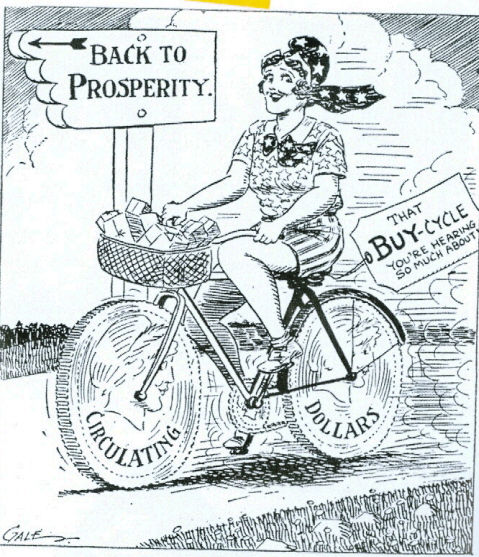In energy, space, time, and money, the bicycle wins hands down as the most efficient means of transport. The bicycle, unlike skiing, began as sport activity and because of its undeniable efficiency in getting from one place to another, it became a means of transport. On a personal scale, car costs are the second highest household expenditure after housing. On average, American’s spend about 17% of their income on their car, maintenance and insurance. We often don’t realize the costs that go into the automobile industry on a national level. The per mile dollar amount we pay for driving is only a fraction of the actual costs, despite the gas tax. Government subsidizes external costs from highway infrastructure to servicing road accidents to parking. The costs of these infrastructure elements are much more expensive than those that would be required for bicycles due to their size, impact, and corresponding loss of the driver's identity. For example, the cost of one car parking spot in a parking structure is estimate $8500 while a bike rack only $50 to build and maintain (City of Eugene, Oregon Traffic Commission). Bicycle sales and riding is an affect of many other variables in the economy. When oil prices rise, we see an increase in bicycle miles travelled. This can be seen in 1978 during the second oil embargo in five years when bicycles sales role above those of automobiles for the first time.
Here are some comparative statistics to put bicycle riding in perspective.
Energy→ To travel only one mile, an average passenger vehicle consume 1860 calories, a train 885, walking consumes 100 calories, but biking only 35 calories per mile. In a car, 95% of the energy used goes to moving the vehicle while only 5% goes to moving the passenger.
Space→ Anywhere from 12-20 bikes can be parked in the area of one car parking spot. Space used for highways, parking garages, driveways and drive-thrus are all exponentially higher for cars than bikes.
Time→ The average American male spent 1600 hours a year in his car, that is 65 days! Most of this time is spent idling in traffic and averaging 17 miles per hour. At this point it doesn’t matter if you drive a Ferrari- a bicycle would get you to your destination faster, by the time you drive around for the average of 10 minutes finding parking.
Money→ About 100 bicycles can be produced for the same amount of resources used to build a mid-sized vehicle. On a personal level, you can calculate how much you would save if you invested the monetary difference in car costs and bicycle costs. Bikes At Work With an annual car costs of $7,754 minus annual bike costs of $220 considering you invested it every year from age 25 to 67 at 8%, you would have an extra $2.3 million in your pocket.
Statistics from: Transportation Almanac
"...the bicycle is the most efficient machine ever created: Converting calories into gas, a bicyclist gets the equivalent of three thousand miles per gallon. A person pedaling a bike uses energy more efficiently than a gazelle or an eagle. And a triangle-frame bicycle can easily carry ten times its own weight-a capacity no automobile, airplane or bridge can match." -- Bill Strickland
 "Bicycle: the History" by David Herlihy
"Bicycle: the History" by David Herlihy
Posted at Dec 18/2008 02:21PM:
chris witmore: Carly, I found over a dozen websites which make the "the average American male spent 1600 hours a year in his car," but I could find no authoritative source for any survey which generated this figure. Please directly cite such number sources.
